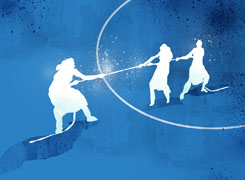Ramalingam Kalirajan |8459 Answers |Ask -Follow
Mutual Funds, Financial Planning Expert - Answered on Jul 08, 2024
He has an MBA in finance from the University of Madras and is a certified financial planner.
He is the director and chief financial planner at Holistic Investment, a Chennai-based firm that offers financial planning and wealth management advice.... more

I am 39 years old having 2 kids 12 and 4 years old.I have home loan of 50 lac and my monthly salary is 1.5 lacs.I have invested 50 lac in mutual funds.My rental income is 35 k.I want to retire when I am 45 years.I am planning to repay my home loan by then.Please help in my financial planning.I need to create a second source of income on which I can survive when I quit my job
Assessing Your Current Financial Situation
First, let’s look at where you stand financially.
You have a monthly salary of Rs. 1.5 lakh and a rental income of Rs. 35,000. This totals Rs. 1.85 lakh per month. You also have a home loan of Rs. 50 lakh and investments of Rs. 50 lakh in mutual funds.
You need to ensure you have a solid plan to pay off your home loan and build a retirement corpus.
Home Loan Repayment Strategy
Paying off your home loan is crucial for your financial freedom. Here’s a plan:
Increase EMI Payments: Use your rental income to make extra EMI payments. This reduces your principal faster.
Lump Sum Payments: Whenever you receive bonuses or extra income, use a portion to make lump sum payments. This also helps reduce the principal amount.
Regular Monitoring: Review your loan statement periodically. Ensure all extra payments are being credited correctly.
By focusing on these strategies, you can aim to clear your home loan by the time you retire at 45.
Building a Retirement Corpus
You need a substantial corpus to sustain your lifestyle post-retirement. Let’s dive into building that corpus.
Mutual Funds: A Powerful Tool
You already have Rs. 50 lakh in mutual funds. That’s a great start. Mutual funds are a fantastic way to grow your wealth due to their power of compounding.
Advantages of Mutual Funds:
Diversification: Spread risk across various assets.
Professional Management: Managed by experienced fund managers.
Flexibility: Easy to enter and exit.
Compounding: Reinvesting earnings generates more income over time.
Categorizing Mutual Funds
Mutual funds come in various categories. Let’s look at a few important ones:
Equity Funds: Invest primarily in stocks. High risk, high return.
Debt Funds: Invest in bonds and securities. Lower risk, stable returns.
Hybrid Funds: Mix of equity and debt. Balanced risk and return.
ELSS Funds: Equity Linked Savings Scheme. Provides tax benefits under Section 80C.
Investment Strategy
To build a retirement corpus, diversify your mutual fund investments. Here’s how:
Equity Funds: Allocate a significant portion here. They offer higher returns over the long term.
Debt Funds: Invest a smaller portion for stability and liquidity.
Hybrid Funds: Balance your portfolio with these funds.
ELSS Funds: Consider these for tax-saving benefits.
Creating a Second Source of Income
Having a second income source is crucial for post-retirement. Let’s explore some options.
Systematic Withdrawal Plan (SWP)
An SWP allows you to withdraw a fixed amount from your mutual fund investments regularly.
Benefits:
Regular Income: Provides a steady cash flow.
Capital Appreciation: The remaining investment continues to grow.
Tax Efficiency: Only the gains are taxed, not the principal amount.
Dividend Income
Investing in dividend-yielding mutual funds can provide regular income.
Benefits:
Steady Cash Flow: Receive regular dividend payouts.
Capital Preservation: The principal amount remains invested.
Fixed Deposits (FDs)
Though not high-return, FDs provide safety and assured returns.
Benefits:
Low Risk: Guaranteed returns.
Liquidity: Can be easily converted to cash.
Building an Emergency Fund
Having an emergency fund is crucial. It should cover at least 6 months of your expenses.
Amount: Calculate your monthly expenses and multiply by 6.
Investment: Keep this in a liquid fund or a high-interest savings account for easy access.
Financial Protection for Your Family
Ensure your family’s financial security with adequate insurance coverage.
Health Insurance
Ensure you have comprehensive health insurance for all family members. This protects your savings from medical emergencies.
Term Insurance
Adequate life insurance is vital. Ensure your term insurance covers at least 10-15 times your annual income.
Education Fund for Your Kids
Start saving for your children’s education early. Here’s how:
Child Plans: Some mutual funds specifically cater to children’s education.
PPF: Public Provident Fund offers safe and tax-free returns.
SIPs: Systematic Investment Plans in mutual funds can be a good option.
Regular Review and Adjustments
Financial planning is not a one-time activity. Regularly review and adjust your plan based on your goals and market conditions.
Annual Review: Reassess your portfolio annually.
Rebalancing: Adjust your investments based on performance.
Goal Tracking: Ensure you’re on track to meet your financial goals.
Final Insights
You have a strong financial base. By strategically paying off your home loan and focusing on mutual fund investments, you can achieve your retirement goals.
Build a diversified mutual fund portfolio to leverage the power of compounding. Consider SWPs and dividend income for a steady cash flow post-retirement. Ensure you have adequate insurance and an emergency fund for financial security.
Regularly review your plan to stay on track. With disciplined investing and smart financial planning, you can retire comfortably at 45 and enjoy a financially secure future.
Best Regards,
K. Ramalingam, MBA, CFP,
Chief Financial Planner,
www.holisticinvestment.in
You may like to see similar questions and answers below
Ramalingam Kalirajan |8459 Answers |Ask -Follow
Mutual Funds, Financial Planning Expert - Answered on Jun 11, 2024
Ramalingam Kalirajan |8459 Answers |Ask -Follow
Mutual Funds, Financial Planning Expert - Answered on Jul 19, 2024
Ramalingam Kalirajan |8459 Answers |Ask -Follow
Mutual Funds, Financial Planning Expert - Answered on Jul 19, 2024
Ramalingam Kalirajan |8459 Answers |Ask -Follow
Mutual Funds, Financial Planning Expert - Answered on Jul 30, 2024
Radheshyam Zanwar |1634 Answers |Ask -Follow
MHT-CET, IIT-JEE, NEET-UG Expert - Answered on May 16, 2025
Radheshyam Zanwar |1634 Answers |Ask -Follow
MHT-CET, IIT-JEE, NEET-UG Expert - Answered on May 16, 2025
Ashwini Dasgupta |107 Answers |Ask -Follow
Personality Development Expert, Career Coach - Answered on May 16, 2025
Ramalingam Kalirajan |8459 Answers |Ask -Follow
Mutual Funds, Financial Planning Expert - Answered on May 16, 2025
Ramalingam Kalirajan |8459 Answers |Ask -Follow
Mutual Funds, Financial Planning Expert - Answered on May 16, 2025
Milind Vadjikar |1236 Answers |Ask -Follow
Insurance, Stocks, MF, PF Expert - Answered on May 16, 2025
Milind Vadjikar |1236 Answers |Ask -Follow
Insurance, Stocks, MF, PF Expert - Answered on May 16, 2025
Ravi Mittal |589 Answers |Ask -Follow
Dating, Relationships Expert - Answered on May 16, 2025
Ravi Mittal |589 Answers |Ask -Follow
Dating, Relationships Expert - Answered on May 16, 2025
Jinal Mehta |99 Answers |Ask -Follow
Financial Planner - Answered on May 16, 2025

























